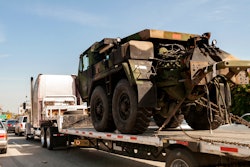Truck drivers will continue to be limited to driving only 11 hours within a 14-hour duty period, after which they must go off duty for at least 10 hours under an Interim Final Rule made public Tuesday, Dec. 11, by the Federal Motor Carrier Safety Administration.
The IFR also retains the provision of the hours rules that allows drivers to restart their cumulative on-duty limits by taking 34 consecutive hours off duty. FMCSA also is seeking comment by late February on its methodology and on safety data that was not available when the agency issued its most recent version of the rules in 2005.
The agency issued the new hours-of-service rule in response to the decision by the U.S. Court of Appeals for the D.C. Circuit vacating those two key provisions of the existing rules. The IFR takes effect Dec. 27 — the same day that a stay granted by the appeals court expires. In order to ensure no gap in coverage of the rules, the IFR temporarily reinstates those two provisions while the agency gathers public comment on its actions and the underlying safety analysis before issuing a final rule.
In its July opinion, the court voided the 11 hours of driving and the 34-hour restart on the grounds that the public didn’t have adequate notice of FMCSA’s methodology for analyzing crash risk. The IFR was developed after new data showed that safety levels have been maintained since the 11-hour driving limit was first implemented in 2003, FMCSA said.
“This proposal keeps in place hours-of-service limits that improve highway safety by ensuring that drivers are rested and ready to work,” FMCSA Administrator John Hill said. “The data makes clear that these rules continue to protect drivers, make our roads safer and keep our economy moving.”
After the IFR becomes effective Dec. 27, there will be a 60-day period for the public to comment on the proposal and its underlying safety analysis. Further analysis after that could take “a few weeks or even a few months,” Hill said. Once a final rule has been established, FMCSA will review longstanding concerns from drivers and carriers over the provision that restricts the sleeper berth split to eight-hour and two-hour periods, Hill said.
Hill noted that the agency also is working to finalize a proposed rule that would require drivers and trucking companies with serious or repeat hours-of-service violations to track their hours of service using electronic onboard recorders.
FMCSA noted that, in 2006, the fatality rate per 100 million vehicle miles traveled was 1.94 — the lowest rate ever recorded. Similarly, since 2003, the percentage of large trucks involved in fatigue-related fatal crashes in the 11th hour of driving has remained below the average of the years 1991-2002. In 2005 alone, the agency noted, there was only one large truck involved in a fatigue-related fatal crash in the 11th hour of driving, while in 2004 there were none.
In addition, between 2003, when the 11-hour driving limit and the 34-hour restart were adopted, and 2006, the percent of fatigue-related large truck crashes relative to all fatal large truck crashes has remained consistent. And the agency’s estimates show that only seven percent of large truck crashes are fatigue-related.
Predictable reaction
The American Trucking Associations welcomed the IFR, saying it retained the key components of the 2004 rule, which ATA has supported because in just four years it has led to significant decreases in the number of fatal large truck crashes, the fatal large truck crash rate, the number of injuries from truck-involved crashes and the injury crash rate.
“FMCSA has made an important contribution to highway safety by keeping in force hours-of-service rules that have led to a reduction in deaths and injuries over the last several years,” said Bill Graves, ATA president and chief executive officer.
The Owner-Operator Independent Drivers Association also expressed support. “We agree with the agency’s decision and appreciate its efforts toward ensuring that professional truckers aren’t hamstrung by regulations that limit their discretion and unnecessarily keep them on the road, tired or not,” said Rick Craig, OOIDA director of regulatory affairs. “We are pleased with having the uncertainty removed, but continue to have concerns about other hours-of-service related matters. We look forward to working with the agency in the coming year through the rulemaking process.”
Consumer advocates claim the industry is putting the public at risk by reissuing the same rule that was struck down in 2004 and this year. “FMCSA is continuing the sweatshop conditions for truck drivers rolling down our highways, which endangers Americans all over the country,” said Joan Claybrook, president of consumer watchdog Public Citizen, which originally brought the case before the appeals court. Most observers expect Public Citizen to challenge the IFR, prompting the next round of litigation.
The Teamsters union added that there has been no peer-reviewed study published that shows the new rule is safer than the previous one. “It’s clear the Bush administration has more loyalty to its corporate supporters than to the men and women who actually drive on our roads,” Teamsters General President Jim Hoffa said.
Adrian Lund, president of the Insurance Institute for Highway Safety, said FMCSA “still believes the way to address the problem of fatigued drivers behind the wheels of big truck rigs is to allow them to drive even more hours than past rules allowed. This is contrary to what the appeals court told the agency, not once but twice, and it’s contrary to what’s rational.”
To view the IFR, click here. To comment, view comments or download supporting documents for the IFR, visit www.regulations.gov and search FMCSA-2004-19608.










